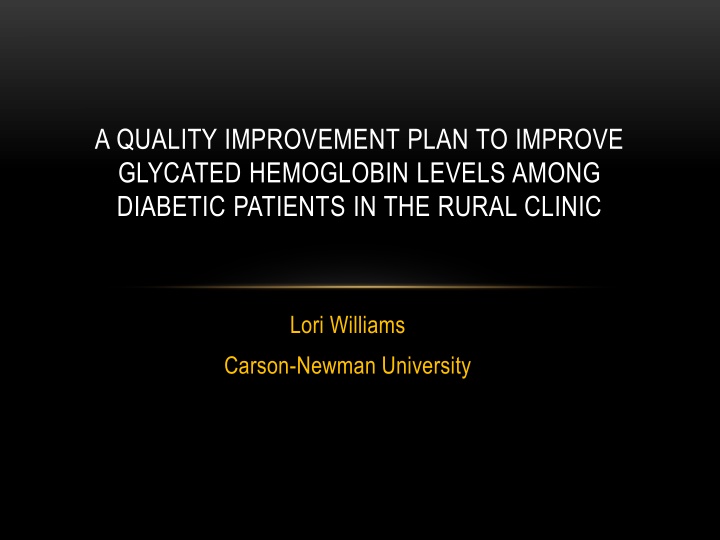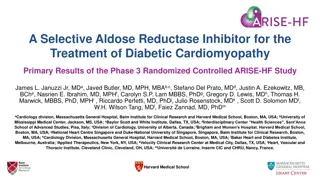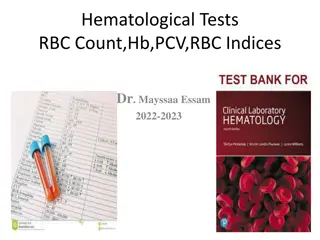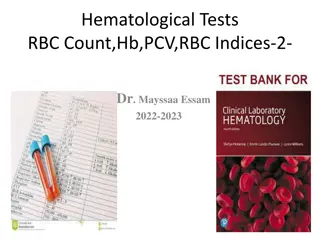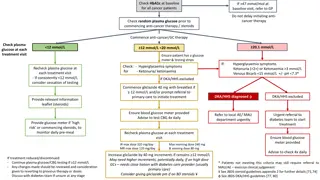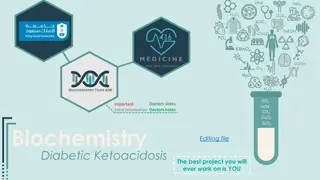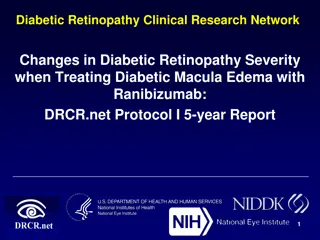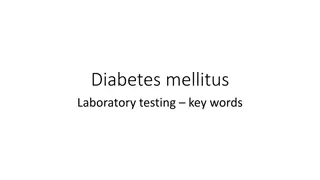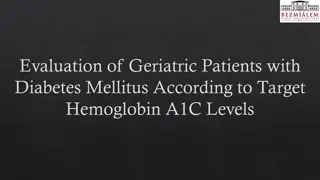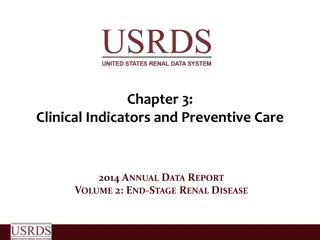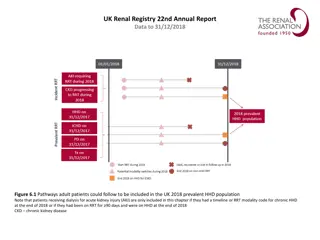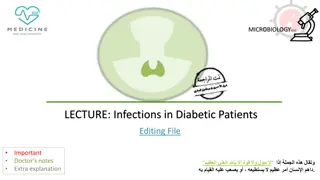Improving Glycated Hemoglobin Levels in Rural Diabetic Patients
A quality improvement plan is essential to address the rising complications of diabetes, especially in rural clinics. Factors like financial disparities, lack of educational programs, and transportation issues contribute to the challenges faced by diabetic patients in these areas. The Diabetes Belt, comprising 644 counties in the Southern US, exhibits higher rates of type II diabetes, obesity, and physical inactivity. Specific statistics related to rural Kentucky and Tennessee highlight the prevalence of diabetes and related disparities in income, age, and race/ethnicity.
Download Presentation

Please find below an Image/Link to download the presentation.
The content on the website is provided AS IS for your information and personal use only. It may not be sold, licensed, or shared on other websites without obtaining consent from the author.If you encounter any issues during the download, it is possible that the publisher has removed the file from their server.
You are allowed to download the files provided on this website for personal or commercial use, subject to the condition that they are used lawfully. All files are the property of their respective owners.
The content on the website is provided AS IS for your information and personal use only. It may not be sold, licensed, or shared on other websites without obtaining consent from the author.
E N D
Presentation Transcript
A QUALITY IMPROVEMENT PLAN TO IMPROVE GLYCATED HEMOGLOBIN LEVELS AMONG DIABETIC PATIENTS IN THE RURAL CLINIC Lori Williams Carson-Newman University
DIABETES: A SERIOUS HEALTH PROBLEM HEALTHY PEOPLE 2020 REPORTS: Diabetes increases the all-cause mortality rate 1.8 times compared to persons without diagnosed diabetes. Increases the risk of heart attack by 1.8 times. Is the leading cause of kidney failure, lower limb amputations, and adult-onset blindness. Diabetes-related complications are rising in part due to the rise in obesity rates. The increase in the number of persons with diabetes and the complexity of their care may overwhelm the health care system. There is a need for Improved diabetes management strategies, especially primary prevention among those at risk for developing type II diabetes. (Office of Disease Prevention and Health Promotion, 2016)
DIABETES FACTS 29.1 million (9.3%) people in the United States have diabetes. Diabetes was identified as the seventh leading cause of death in 2010 and may be higher. Type II diabetes represents 90-95 % of all diagnosed cases. Diabetes is associated with serious complications such as kidney disease, heart disease, stroke, blindness, neurovascular disease, limb amputations, and death. In 2012, diabetes cost $245 billion dollars in direct expenditures, disability, loss of productivity, and premature death. (Centers for Disease Control [CDC], 2014)
A PATIENT FOLLOWED IN A RURAL CLINIC IS More likely to skip appointments for preventive screenings. Likely to find few educational programs related to diabetes. More likely to face financial, insurance, and transportation disparities. 17% more likely to be diagnosed with diabetes. Likely to have a higher rate of morbidity from diabetes: Increased rate of retinopathy Rural Latino populations have increased rate of limb amputations. (Bolin, Bellamy, Ferdinand, Kashmir, and Helduser 2015).
THE DIABETES BELT Identified by the CDC as a population more likely to have type II diabetes. Located throughout the Southern region of the United States. Encompasses 644 counties in 15 states. Nearly 12% of people in this region diagnosed with diabetes; compared with 8% outside this region. Rates of obesity and physical inactivity are high in this area. (CDC, 2011)
DIABETES FACTS RELATED TO RURAL KENTUCKY AND TENNESSEE Kentucky Tennessee 17% of the population have been told they have diabetes. 17.9% of the population have been told they have diabetes. 18.2% have an annual income of $25,000 or less. 18.5% have an annual income of $25,000 or less. 24.5% are 65 years of age or older. 24.9% are 65 years of age or older. Race/Ethnicity Race/Ethnicity White 12.5% White 12.8% Black 15.8% Black 16.1% Hispanic 3.3% Hispanic 2.3% American Indian 15.0% American Indian 26.4% (United Health Foundation [Kentucky], 2016) (United Health Foundation [Tennessee], 2016)
A RURAL AREA IN KENTUCKY 32.5% of the population is obese. 68.8% of the population is overweight 28.6 % report being sedentary. 10.5% have been diagnosed as diabetic. (15% diagnosed diabetic in Hardin Co.) (Lincoln Trail Health Department, 2015)
THE PROBLEM Patients identified with diabetes and pre- diabetes have increasing non-compliance rates returning for follow up evaluation and management of HgbA1c levels..
HOW CAN THE RURAL CLINIC BECOME MORE EFFICIENT IN THE MANAGEMENT OF TYPE II DIABETES? Point of care (POC) testing of glycated hemoglobin levels (HgbA1c) may be a solution. POC testing of HgbA1c is available. It is utilized in hospital, clinic, and office settings. HgbA1c is a dependable indicator of blood glucose management, the diagnosis of diabetes, and potential future complications. (Jones, 2014)
WHAT IS POINT OF CARE TESTING? Point of Care testing is a diagnostic test carried out at the patient bedside or near the patient. Results are usually calculated through a small device, utilizing a drop or small sample of whole blood on a strip or cartridge. Results of test are obtained within a few minutes or immediately. Usually performed by non-laboratory personnel. Machines may require routine calibration. May be subject to State and Federal compliance regulations within a small practice. (Jones, 2014)
ADVANTAGES OF POC TESTING OVER CONVENTIONAL LABORATORY TESTING TRADITIONAL LABORATORY POC TESTING Requires small venous blood sample or finger stick sample. Requires venipuncture sample. Patient must return to the clinic in 1-2 weeks for evaluation of results. Will yield rapid, onsite results. Patient receives plan of care and prescriptions at visit. May delay plan of care and prescriptive management. Reduced cost, time, and travel to the clinic. Patient must arrange and pay for extra visit. (Jones, 2014)
POC TESTING OF HGBA1C INCREASES PATIENT SATISFACTION AND COMPLIANCE. A report by Jones (2014) suggests that POC testing of HgbA1c levels: Whitley, Young, and Rasinen (2015) report: Improves patient satisfaction levels. Patients receiving immediate on site feedback had a 52% increased likelihood of clinical interventions being initiate. An Immediate plan of care and medications results in better outcomes and reduced HgbA1c levels. The end result was reduced HgbA1c levels > 1% point within a 12 month period. Reduced cost, time, and visits are appealing to the patient.
POC TESTING LOWERS COST For each point that an HgbA1c level is above 6%, healthcare expenditures rise between four percent and 30%. Long term, the patient with complications from diabetes may pay several thousands of dollars more than a patient with no complications. Patients experience reduced cost by eliminating extra visits and travel time to the clinic. Stricter glycemic control, minimizes complications. (Whitley, Young, & Rasinen, 2015)
IMPLEMENTING THE PLAN When choosing an analyzer look for: Patient safety features. Ease of use. Size of sample. Time to result. Ease of calibration and reagent testing. Does unit meet quality standards. Consider cartridge storage, and location. (Whitley, Young, and Rasinen, 2015).
IMPLEMENTING THE PLAN Establish an education plan that includes staff and patient teaching Tools to assist the provider can be found through the American Diabetes Association (ADA) and the Diabetes Self-Management Education (DSME) websites. Assist willing patients to enroll in the free ADA Living with Type 2 Diabetes Program at http://www.diabetes.org/living-with- diabetes/recently-diagnosed/living- with-type-2-diabetes/ (Ross et al., 2015).
IMPLEMENTING THE PLAN Adhere to evidenced based guidelines: Successful provider management and glycemic control is dependent on following evidenced based guidelines. These resources help the provider make sound disease management decisions. Successful self-management of diabetes care is dependent on evidenced-based care. (Ross et al., 2015).
THE CLINIC PLAN A Plan to Decrease HbA1c Levels in the Rural Clinic Project: Implement Point of Care (POC) Testing of Glycated hemoglobin (HbA1c) in the rural clinic. Quality Improvement Team: Provider APRN, Clinic LPN, Clinic Certified Lab Technician, Medical Secretary Plan: To develop a more efficient means of managing care and treatment of the adult patient with Type II Diabetes through POC testing of HbA1c levels. By reducing costly conventional lab testing, patients will receive immediate consultation, treatment, and prescriptive management, if indicated. More efficient intervention will lead to greater patient compliance, satisfaction, and reduction of disease complications. Process: Obtain desktop HbA1c analyzer and testing cartridges for the clinic. Work with device representative to arrange training, set up certification and competency requirements, and establish requirements for quality checks. Review American Diabetic Association (ADA) evidenced based guidelines for treatment of Type II diabetes. Develop a teaching plan for patients identified with pre-diabetes utilizing ADA toolkit. Enroll willing patients in free ADA Living with Type 2 Diabetes Program. Print and assemble patient teaching materials. Establish a clinic policy for documentation of results, actions required for abnormal results, back up laboratory Identify a diabetes team in the clinic to carry out testing, teaching, and patient consultation. Begin testing Measure: Document results, re-evaluate weekly for suggestions for improvement from staff and patients. Re-evaluate program by auditing subsequent HbA1c levels for improvement at 3, 6, and 12 month intervals. Patients with POC HbA1c levels >6.5% who receive immediate consultation and treatment options will have a 0.5-1.0 point reduction in HbA1c level within six months. Patients with POC HbA1c levels of <6.5 will not have an increase of HbA1c.
REFERENCES Bolin, J., Bellamy, G., Ferdinand, A., Kashmir, B., Helduser, J., [Eds.]. (2015). Rural Healthy People 2020. Vol. 1. College Station, Texas: Texas A&M Health Science Center School of Public Health, Southwest Rural Health Research Center. Retrieved from https://sph.tamhsc.edu/srhrc/docs/rhp2020.pdf Centers for Disease Control and Prevention [CDC]. (2011). CDC identifies diabetes belt. Retrieved on 10/27/2016 from http://www.cdc.gov/diabetes/pdfs/data/diabetesbelt.pdf Centers for Disease Control and Prevention [CDC]. (2014). National diabetes statistics report, 2014. Retrieved on 10/27/2016 from http://www.cdc.gov/diabetes/pubs/statsreport14/national-diabetes-report-web.pdf Jones, G. (2016). The continuing case for point-of-care testing for HbA1c. MLO: Medical Laboratory Observer, 48(8), 22-24. Retrieved from http://0- content.ebscohost.com.library.acaweb.org/ContentServer.asp?T=P&P=AN&K=116948206&S=R&D=ccm&EbscoContent=dGJyMNLr40SeqLA4zOX0OLCmr06eprVS sKq4SLGWxWXS&ContentCustomer=dGJyMPGusU6zr7NMuePfgeyx43zx Lincoln Trail District Health Department. (2013). Health report card. Retrieved from http://lincolntrailhealthdepartment.com/wp-content/uploads/2015/01/Health- Report-Card-2013-Final.pdf Office of Disease Prevention and Health Promotion. (2016). Diabetes. In Healthy People 2020. Retrieved from https://www.healthypeople.gov/2020/topics- objectives/topic/diabetes Ross, S., Benavides-Vaello, S., Schumann, L., & Haberman, M. (2015). Issues that impact type-2 diabetes self-management in rural communities. Journal of the American Association of Nurse Practitioners, 27(11), 653-660. doi:10.1002/2327-6924.12225 United Health Foundation (2016). County Health Rankings. Kentucky: Diabetes. Retrieved from http://www.americashealthrankings.org/explore/2015-annual- report/measure/Diabetes/state/KY United Health Foundation (2016). County Health Rankings. Tennessee: Diabetes. Retrieved from http://www.americashealthrankings.org/explore/2015-annual- report/measure/Diabetes/state/TN Whitley, H., Ee Vonn, Y., & Rasinen, C. (2015). Selecting an A1C Point-of-Care instrument. Diabetes Spectrum, 28(3), 201-208. doi:10.2337/diaspect.28.3.201
